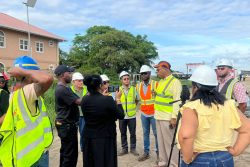Introduction
When ExxonMobil and partners announced their first discovery in May 2015, this was preceded by 45 unsuccessful wells drilled over five decades. From May 2015, to the end of the first year of oil exports, 17 more discoveries were announced by 2020. By any metric, this is a phenomenal creaming curve; and indeed, historically unprecedented.
In 2016, I had ventured the view that, Guyana’s petroleum resources far exceeded the then Exxon Mobil estimate of 600 million to 1.3 billion boe, announced soon after its 2015 discovery. Many urged then, and some still do so now that, my initial estimate of 13-15 billion boe by the early 2030s, was hopelessly optimistic.
I indicated my estimate was founded on two lines of argument. The first of these, is an appreciation of Guyana’s petroleum geology, as expressed in the geological principle of the “Atlantic mirror image”, And the second, is the estimate provided by the United States’ Geological Services (USGS).
Of important note, is that, Guyana’s crude is low emissions, classed as “medium sweet”; with an API >35 and low Sulphur content of 0.5.
Reasoning 1, Mirror Image
This posited the geoscience theorizing that Guyana’s crude stemmed from the drifting apart over geological time of earth’s super-continent [unified South America and Africa]. This separation resulted in the Guianas Equatorial Margin (encompassing both offshore and onshore portions of Guyana, Suriname, French Guiana, as well as limited portions of Venezuela and Brazil).
Consequently, the petroleum geology of the Guianas area closely resembles that of West Africa. It includes two sedimentary basins, namely, the Guyana-Suriname Basin and the Foz do Amazonas Basin. Geoscientists further posit that, the Guianas Equatorial Margin/Guianas Basins is separated by the Demerara Plateau, which is a structurally high, thick succession of Jurassic and Lower Cretaceous carbonate-rich sediments.
This circumstance yields the thesis that, the petroleum system of the Guianas Basin is a “mirror-image” of West Africa’s petroleum system, where several large hydrocarbon accumulations have been found, including, the famed Jubilee discovery, offshore Ghana.
Reasoning 2, USGS Assessment
My second justification is based on two USGS’ World Energy Assessments of Undiscovered Oil and Gas Resources in Central and South America as well as the Caribbean (2000 and 2012). The information provided there is “fully risked”, with estimates given, at levels of 95, 50, and 5 percent probability. The mean probability is also reported (where fractiles are additive, assuming perfect positive correlation). The estimates given for gas include all liquids. Undiscovered gas resources are the sum of non-associated and associated gas.
Other dedicated estimates
Thus far, I have relied heavily on Rystad Energy’s studies and data mining in the reporting of Guyana’s reserves. However, in truth there are three separate estimates of its current recoverable resources which are worth citing, in this effort at taking stock of this measure.
These are, first, ExxonMobil and partners [Contractor] estimate of 11 billion plus barrels of oil equivalent, boe. I admit that I remain unclear as to whether this Operator’s estimate refers solely to its Stabroek Block holdings or the Guyana-Surinam Basin. Or indeed a deliberate tactical understatement. Second, the Government of Guyana has included in its public auction invitation the statement that the bidding is for 24 billion boe. Third, my estimate which is re-visited here.
My gauging of Guyana’s recoverable resources is based on two primary drivers. Firstly, a bullish outlook on Guyana’s hydrocarbons potential. And, second the incentivizing/ dis-incentivizing investor “resource price” set by the ruling Stabroek PSA.
Second, amplifying this consideration, my reading reveals Guyana’s shared geological structures with West Africa support the bold thesis of the petroleum system of the Guianas Basin being a mirror-image – labeled the “Atlantic Mirror” theory – of the petroleum system present in West Africa, where several elephantine petroleum accumulations have been discovered in recent years, including, the Jubilee discovery offshore Ghana.
Additionally, the results of two United States Geological Service, USGS, surveys, 2000 and 2012. formed the basis for my initial prediction of Guyana’s hydrocarbon resources. I have updated that prediction as follows.
Representing the USGS results on a continuum, I opined that the reported 95 percent confidence value data reflect what I interpret as a conservative interpretation of the geological data. And, by parity of reasoning, the 5 percent value represents a more expansive valuation. The middle position on this continuum is represented by the 50 percent value and the mean likelihood, as defined in the USGS Report. Taking the above into consideration I initially chose the mean likelihood from both surveys and then rounded up to the nearest whole number to arrive at 13-15 billion boe.
More heroically, I now assume this circumstance supports the thesis of asymmetric risk. That is, the decision agents in the sector [both resource Owner and lead Contractor for operations] are vested in the likelihood [thesis] that. the reward outcome [resource finds] will be greater or lesser than is the norm depending on the placement on confidence interval. Risk is not assumed to be distributed “as likely or not”, equally along the continuum. The upside risk is therefore, more appealing to both Owner and Contractor.
The USGS reports that their results are based on a probabilistic method where 1] estimated reserves are fully risked 2] estimates are confined to conventional resources 3] on the probability distribution curve. Fractiles F95, F50, F5 and the mean reveal the estimated amounts to that value and their chances for the minimum attained. Thus, for example F95 reveals the “at least” amount that is expected with a 95 percent choice of finding.
Extrapolating from a laundry list of considerations not repeated here I moved from the search for a mid-point on the continuum, to one closer to the 5 percent confidence value and consequently riskier. My best guess now is a 10 percent Fractile, yielding about 28-30 billion boe.
Conclusion
Next week I offer a wrap-up column.






